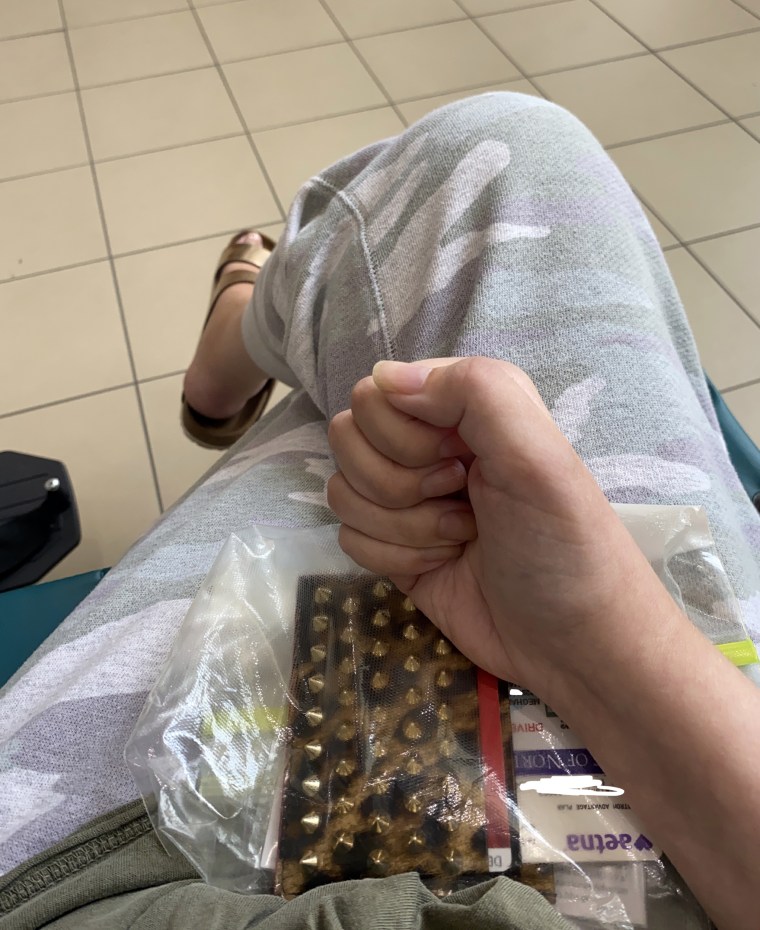When Meghan Bradshaw began fainting and experiencing joint pain, she visited many doctors. At first, they suspected that she might have a vitamin D deficiency or that she was anemic. By her early 20s, her symptoms became “debilitating” and she passionately searched for answers. After years of being misdiagnosed, she learned she has Lyme disease, which caused arthritis, leading to 16 joint surgeries before the age of 30.
“While it’s extreme, my story really highlights a lot of the things that other people experience, like delayed diagnosis and misdiagnosis and having a general unawareness of the dangers of ticks,” the 29-year-old from Charlotte, North Carolina, told TODAY.
Strange symptoms with no easy diagnosis
While Bradshaw recalls having some symptoms in high school, she really noticed an onset in college. At first, they were nonspecific, such as fainting or tiredness but then she started experiencing joint pain that impacted her ability to walk and care for herself.

“I started seeing specialists. We thought maybe I had Crohn’s or colitis because my mom had a history of that. We were looking at lupus, (multiple sclerosis), (rheumatoid arthritis),” Bradshaw said. “Seriously everything in the autoimmune world and all of the different tests at that point had come up inconclusive.”Finally, a doctor diagnosed her with rheumatoid arthritis when she was 23, even though she didn’t quite meet the criteria.
“I did not have the rheumatoid factor. (The doctors said), ‘This is the closest thing that we can give you so we’re just going to treat you,’” Bradshaw recalled. “I was really excited because I had been desperate for a diagnosis at that point.”
At the time, her pain felt so intense and widespread she couldn’t care for herself. Her mom helped her brush her teeth and dress, for example. She started several immunosuppressive drugs, steroids and biologics and she changed her diet and cut out alcohol.
“I was doing everything, all the right things, to try to help myself and reduce my inflammation,” Bradshaw explained. “This pain in my body that was just so widespread and we couldn’t figure out where the heck it was coming from.”
The treatment for rheumatoid arthritis helped her regain some of her ability but then she started needing to have joints replaced and reconstructed. She’s had total joint replacements in both shoulders, hips, knees and ankles and joint reconstructions in her hands and needed a wheelchair and other mobility devices.
“My lower extremities have essentially been reconstructed at this point,” she said. “I have had my fingers fused because the arthritis was so bad.”

The arthritis in her hands and fingers caused her hands to be permanently in fists until surgery moved them into “ a curved position and fixed them with a metal rod.” She can’t bend her hands, but she has about “70% of her function.”
Bradshaw also learned she had Ehlers-Danlos syndrome, a connective tissue disease. But still, it didn’t explain why she was so young and experienced so many total joint replacements and reconstructive surgeries. Finally, three years ago she was diagnosed with Lyme disease, which had caused Lyme arthritis.
“It was a huge relief because it was like, ‘OK, great, now we know what’s causing all this,’” she said. “At the same time it was obviously really frustrating because the misdiagnoses that I had been given and the delayed diagnosis that I had experienced caused further complications.”
What is Lyme arthritis?
Lyme disease is a tick-born illness caused when a tick with bacteria Borrelia burgdorferi bites a person, according to the U.S. Centers for Disease Control and Prevention. People with it experience fever, headache, exhaustion and a bullseye skin rash. If diagnosed early, antibiotics can treat it, reducing the chances of complications. Though many people remain unaware they have it, which can lead to problems with the heart, nervous system and joints.
The CDC estimates that as many as 476,000 Americans contract Lyme disease each year. Lyme arthritis remains less common.

“When Lyme disease does affect the joints, it usually the knee or just one joint,” Dr. Glenn Gaston, a hand specialist at OrthoCarolina, told TODAY. “If patients get treatment, most of them don’t get arthritis. But even if they do get treated with antibiotics early, about 10% will still get arthritis.”
When Lyme disease goes untreated, the chance of developing arthritis increases. Lyme arthritis often starts in the knee, Gaston said.
“About 60% will end up with some arthritis,” Gaston said.
Gaston performed surgery on Bradshaw’s hands, which has helped her regain some use of them.
“When I first met Meghan, she could not hold anything,” he said. “She couldn’t even touch her face. She was in a wheelchair. Her dad basically took full time care of her.”
Gaston notes that the severity of Bradshaw’s situation is somewhat unique.
“Hers is all over. If you look at her treatment she’s had both hips, knees, shoulders replaced,” he said. “She’s the worst case of Lyme disease. There’s never been a patient in a textbook or an article that I’ve seen that is anywhere close to hers.”
For most people, medications can treat the joint problems.
“The chance of a patient with Lyme getting to the stage Meghan is in is unbelievable rare,” Gaston said.

Gaston said raising awareness of Lyme disease remains essential. People who are outdoors, especially in the Northeast, should check their bodies for ticks afterward. If they develop any symptoms, they should contact their doctors. There are blood tests that can determine if people have it. Early treatment leads to fewer complications.
“If you get to it early and treat it, your odds (of developing arthritis) go significantly down,” Gaston said.
Raising awareness
For the first time in two years, Bradshaw began walking and she was able to leave her house recently without a wheelchair. But it can be tough. When she uses a wheelchair, people often stare at her and ask her what’s wrong. Sometimes, she uses these awkward moments as a learning experience.
“I see it as an opportunity to educate some people who are genuinely curious about tick-borne diseases and disabilities and joint replacements,” she said. “But it’s really exhausting when every time you leave your house you know that a stranger is going to ask you a question because they feel like you owe them your medical trauma.”
She has donated five of her joints to a researcher hoping to understand why Lyme caused so much damage and she raises awareness of tick-borne diseases. As a graduate student of public health, Bradshaw hopes to change policy regarding Lyme and wants children to learn how to do tick checks so they grow up aware of their risks.
“What they learn in school, they take home and teach their families and they teach their communities,” Bradshaw said. “This is something that should be taught as a fundamental life skill.”

While she understands health disparities exist and people are often dismissed, she hopes her story encourages people to become their own health advocates.
“I don’t want this to be a sad story. It’s not. It could very easily have been,” Bradshaw said. “I hope that it inspires people to do something. Find something that you care about and do something whether it is dedicating your time, your resources, your voice to help make a difference.”